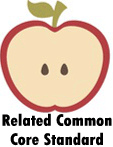Sentence Pattern Worksheets
Related ELA Standard: L.6.3.A

We all have habits or patterns that we develop over time. When writing, we are no stranger to patterns either. Typical sentences have three main players: the subject, the verb, and the clause connectors. The subject tells us the who. The verb tells us the action the subject is taking or the state of being of that subject. The clause connector is a product of how those two interact. These worksheets will take students deep with the patterns that develop between the authors and their sentences.
Sentence Pattern Worksheets To Print:
How Does That Go? - Which is it: when, where, why or how? Now insert a beginning phrase for each sentence that tells when, where, why or
how. The word in parentheses will tell you which kind of phrase to insert.
Varying It Up - Just a quick tune up of a few sentences should be good to go. Rewrite the paragraph using some beginning phrases.
Too Sick for the Sock Hop - Fix the begin to this sick day. This paragraph explores Carol's experience at the local sock hop.
The Basics - What they heck are all of these asking? Locate that phrase and explain the purpose behind it.
Introductory Phrases - This is a two part-er for you. You saw something like this earlier, we give more practice.
Keep It Flowing - Rewrite the paragraphs using some beginning phrases. You will need to make it much more engaging for your readers. This is pretty slow going.
Scratchy Variations - Rewrite each passage, varying the sentence structure. You may add detail or combine them, whatever you feel helps the message flow the best.
Introductory Phrases - Rewrite each sentence below, adding an introductory phrase that tells how, when, why or where.
Adding Some Interest - Rewrite each sentence below, adding an introductory phrase that tells how, when, why or where.
Kick It Off - Rewrite each sentence below, adding a beginning phrase that tells how, when, why or where.
Keeping Their Interest - Rewrite the story below, varying the sentence structure. You may add details or combine sentences.
Picnic! - Write a paragraph that includes each of the following people, events and settings.
Be an Original - Write 5 original sentences. Include an introductory phrase for each as indicated in parentheses.
How to Spot Sentence Patterns
PHere are the four most common types of sentence patterns.
Simple Sentence
The first sentence pattern is that of a simple sentence. The simple statement does not contain any complexities. It is very easy to identify. It is also one of the first entry patterns that are taught to young students. The simple sentence is made up of only one independent clause. The simple form can be easily made and spotted. It has only two elements i.e. subject and verb.
For example,
They live in Oxford.
Here, the subject is they and the verb is live.
Josh eats an apple.
Here, the subject is Josh and the verb is eats.
Compound Sentences
The second sentence pattern is the compound sentence. The compound sentence contains two or more than two independent clauses. The clauses of a compound sentence are separated by comma or a connector.
For example,
Ashley exercises daily in the morning, and doctors say it is healthy.
Here, the independent clauses are joined together with a comma and the connector "and".
Complex Sentences
The flow pattern of a complex sentence contains an independent clause and one or more than one dependent clauses. There are many ways to create this types of statements. The connectors can be used in the starting of the dependent clauses. For example,
Although canned food tastes amazing, I prefer organic and fresh food.
Compound-Complex Sentences
Compound-complex sentences are the longest in form. They contain two or more independent clauses and two or more than two dependent clauses. Connectors also play a vital role in this sentence pattern. For example,
Ashley said that she will help us in the project; However, if she does, her work will suffer, but I can help her with her work.

